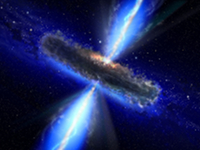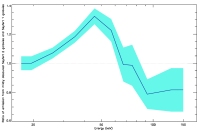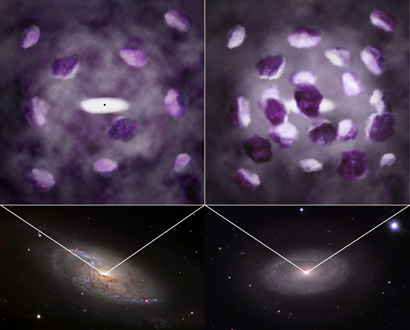INTEGRAL observations suggest unified model for AGN requires a rethink
2 August 2011
Scrutinising a large sample of Active Galactic Nuclei with INTEGRAL, astronomers have found that, unexpectedly, sources affected by stronger absorption at lower energies show an excess emission in the hard X-ray band when compared to their less obscured counterparts. The excess is likely due to reflection of X-rays off the same dense clouds responsible for absorption. Unaccounted for in the unified paradigm of Active Galactic Nuclei, the finding calls for a rethinking of some of this model's facets. The reflected radiation could also represent the long-sought missing part of the Cosmic X-ray Background.
 |
|
Artist's impression of an AGN according to the unified model. |
Astronomers explain the wide variety of features discerned in different classes of AGN in terms of the anisotropic geometry of the black hole's immediate surroundings. The accreting black hole is fed via a disc, and a thick, obscuring torus of gas and dust is believed to encompass the disc and to absorb part of the radiation it emits.
Depending on the orientation of the torus with respect to an observer's line of sight, the view to the galactic nucleus may be obstructed to varying degrees. This 'unified' model, which provides a phenomenological interpretation of the observed AGN diversity, is now questioned, at least in part, by a new study performed with ESA's INTEGRAL observatory.
"The unified model predicts that all AGN exhibit the same behaviour when observed at hard X-ray wavelengths, regardless of the different emission they might show in other bands," explains Claudio Ricci, a PhD student from the Data Centre for Astrophysics (ISDC) at the University of Geneva, Switzerland. Ricci is the lead author on the paper reporting on the study and published online on 2 August 2011 in Astronomy & Astrophysics. "Absorption by the torus is weaker for photons with increasing energy, and it should have no effect at all, for the objects in our sample, on the hard X-ray photons probed by INTEGRAL," he adds.
To test this framework, Ricci and colleagues put together a sample of 165 AGN observed with INTEGRAL during its first 8 years of operation at energies between 20 and 250 keV. The sample comprises AGN subject to absorption at lower energies and also unabsorbed ones. "We expected to see no difference between classes, but instead we noticed two very distinct trends in the data," he notes.
Surprisingly, the sources affected by stronger absorption at lower energies (i.e. from the infrared to the soft X-ray bands) show an excess of emission, with respect to their less obscured counterparts, in the energy range 30–60 keV. No appreciable difference is observed at higher energies. The excess emission is a signature of X-rays being reflected off neutral hydrogen gas in the dense clouds that surround the black hole and disc, possibly the same clouds responsible for absorption at lower energies.
 |
|
Emission ratio between different types of AGN in the hard X-ray regime as observed by INTEGRAL. |
"A significantly stronger reflection in a certain class of AGN indicates that the environment of these objects is different," comments co-author Roland Walter, who is the Principal Investigator of the INTEGRAL team at the ISDC. "The discrepancy in the high-energy emission properties of different AGN types is unaccounted for in the leading theoretical framework and calls for a rethinking of some of its details," he adds.
In the light of the new data, the unified model's basic assumption that the same central engine powers all AGN is safe. However, the presumed existence, in all of them, of an anisotropic, toroidal structure needs revision. "We argue that various classes of AGN are characterised by a substantially different distribution of absorbing material around the black hole," notes Walter.
The team advocate a patchy but overall isotropic morphology for the absorber. In this scenario, the density of clouds around the central source would determine the amount of reflected X-rays, with denser environments resulting in stronger reflection. The astronomers speculate about whether such morphological variations could characterise objects at different evolutionary stages, although the issue is still unclear and the subject of further investigation.
The discovery of X-ray reflection by AGN has another, far-reaching implication in the debate about the Cosmic X-ray Background (CXB), a tenuous, diffuse background radiation that pervades the X-ray sky from all directions. The CXB consists of the cumulative X-ray radiation emitted by all unresolved active galaxies across cosmic history. As this diffuse background peaks in the hard X-ray regime probed by INTEGRAL, identifying its individual sources has been among the mission's main science goals ever since it began operations.
"One of the observatory's milestones was the first accurate measurement of the CXB intensity in the energy range where its emission is stronger," notes Chris Winkler, INTEGRAL Project Scientist at ESA. Achieved in 2006, this result did not solve, but in fact deepened, a long-standing debate about the origin of the CXB. The measured intensity appeared to be far greater than that which astronomers could predict by modelling observations of individual AGN and summing their contributions. To match the measured value, a much larger number of heavily obscured AGN than has been observed was required.
Now, the study by Ricci and his colleagues proposes a fresh solution to the puzzle: when the reflected X-rays are added to the total budget of radiation sources in the CXB, invoking sources that have never been observed may no longer be necessary.
"The result relies on several years of data acquired with the most sensitive hard X-ray telescope currently in operation," comments Winkler. "By showing us where the missing part of the CXB lies, INTEGRAL might have solved a 30-year long mystery," he concludes.
Notes for editors
The study presented here is based on public data gathered by the IBIS/ISGRI imager on board INTEGRAL during the mission's first 8 years of operation, between 20 and 250 keV. The sample consists of 165 Seyfert galaxies at redshifts z<0.2, of which 44 are Seyfert galaxies of type 1, 29 are Seyfert galaxies of type 1.5, 78 are Seyfert galaxies of type 2 and 14 are Narrow-line Seyfert galaxies of type 1.
At energies ranging from the infrared to the soft X-ray spectral bands, Seyfert 1 galaxies are less affected by absorption, whereas Seyfert galaxies of type 1.5 are characterised by stronger absorption and Seyfert 2 galaxies experience even stronger absorption. Among Seyfert 2 galaxies, the Lightly Obscured (LOB) objects are affected less by absorption when compared to the Mildly Obscured (MOB) ones.
When considering the full sample, the study reveals an excess emission at energies between 30 and 60 keV in Seyfert 2 galaxies when compared to Seyfert 1 and 1.5 galaxies. An analysis of a sample consisting only of Seyfert 2 galaxies reveals a similar excess in MOB objects with respect to LOB ones.
INTEGRAL is an ESA project with instruments and science data centre funded by ESA Member States (especially the PI countries: Denmark, France, Germany, Italy, Spain, Switzerland) and Poland, and with the participation of Russia and the USA.
Related publications
C. Ricci, R. Walter, T. J.-L. Courvoisier & S. Paltani, "Reflection in Seyfert Galaxies and the Unified Model of AGN", Astronomy & Astrophysics, 2011, 532, A102
Contacts
Claudio Ricci
ISDC, Data Centre for Astrophysics
University of Geneva
Switzerland
Email: Claudio.Ricci unige.ch
unige.ch
Phone: +41 22 379 21 22
Roland Walter
ISDC, Data Centre for Astrophysics
University of Geneva
Switzerland
Email: Roland.Walter unige.ch
unige.ch
Phone: +41 22 37 92 128
Chris Winkler
INTEGRAL Project Scientist
Research and Scientific Support Department
Directorate of Science and Robotic Exploration
ESA, The Netherlands
Email: cwinkler rssd.esa.int
rssd.esa.int
Phone: +31 71 5653591


